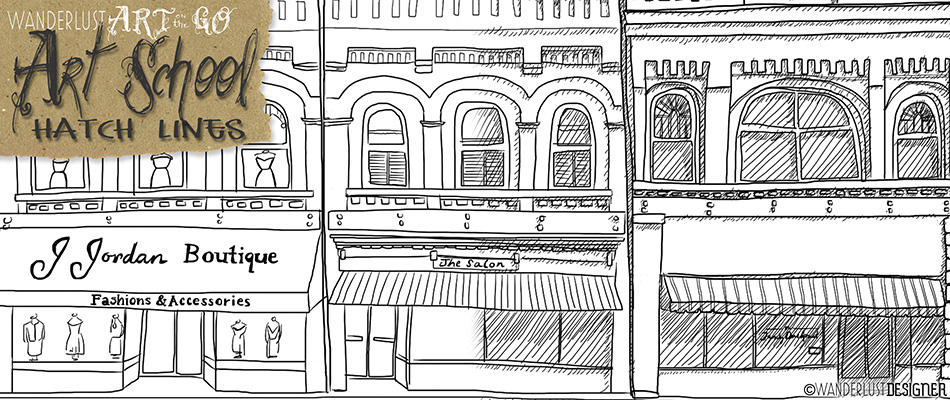Art on the Go: Art School – Line Basics: Hatch and Marks to Imply Light and Dimension

Hatching or adding hatch marks is a technique used to add dimension and tonality to line art. It adds dimension to a simple line drawing by implying light and shadow. The hatch marks are used to indicated the shadow. It also adds tonality (or a range of tones) to a simple line drawing creating more interest. Hatch lines or marks are a simple and easy way to add pop to your everyday line art.
Examples of Different Hatch Marks
There are several different ways to create hatch marks. Below are 9 different examples, yet don’t let this list limit you. These are just some of the basic hatching marks, but with a little touch of creativity, you surely can come up with others!

- Simple Hatch Mark – These are just simple parallel lines drawn in areas where you want to imply shadow.
- Contour Hatch Mark – These are parallel lines but drawn in a contour shape to match the object.
- Contour Cross Hatch Mark – This is the same as #2, yet cross parallel lines are added for more definition.
- Straight Cross Hatch Mark – This is using technique #1, but adding cross lines to add more definition.
- Dash Marks – Hatching can be created by just drawing quick dash lines.
- Dot Marks (or Stippling) – Dimension (or light and shadow) can be created by adding dots where the shadow falls.
- Scribble Marks – A hatch mark does not need to be straight or even a line, it can be a scribble too!
- Multiple Contour Cross Hatch – When more lines are layered between other lines, it gives the drawing even more definition of shape.
- Varied Weight Cross Hatch Lines – Varying your cross hatch line weights can also add more definition to a shape.
Line Art Example With and Without Hatch Marks
Below is a comparison drawing of a contour line drawing with and without hatch marks. Although the simple contour line drawing on the top has plenty of detail and interest and even implies dimension with the store front awnings, it lacks the tonality which can give a greater sense of light and shadow. Adding the hatch marks as seen in the bottom drawing definitely gives that extra “pop.” The hatch marks clearly helps define the details of the architecture (ornate tops of the buildings) as well as emphasis the shadows that are being cast on the windows by the awnings and depth of the window frames.

Art School Assignment
It’s time to add that same “pop” to your line art drawings. Start simple with just making different markings on a piece of paper in a simple shape like a square or circle like the example in this article. Perhaps after you’ve made several different markings you find you prefer one or two from the bunch. Next create a slightly more complex line drawing. Fruit is a great subject matter to draw to experiment with hatch marks. Draw a simple banana, an apple, some grapes. Now add your favorite hatch marks. To know where to draw the hatch marks, pretend there is a huge spot light on one side of the fruit. Now add your hatch marks on the opposite side of your imaginary light. Once you are done, do you think the hatching enhance the look of the fruit? Does it add interest to your drawing?
Now with a little practice, it’s time to take your hatching technique on the go! Bring your sketchbook to your next outing at the cafe, whether that be in your home town, or a quaint corner in Paris. Draw your coffee and pastry, and be sure to add your hatch marks. I look forward to seeing your sketch!


